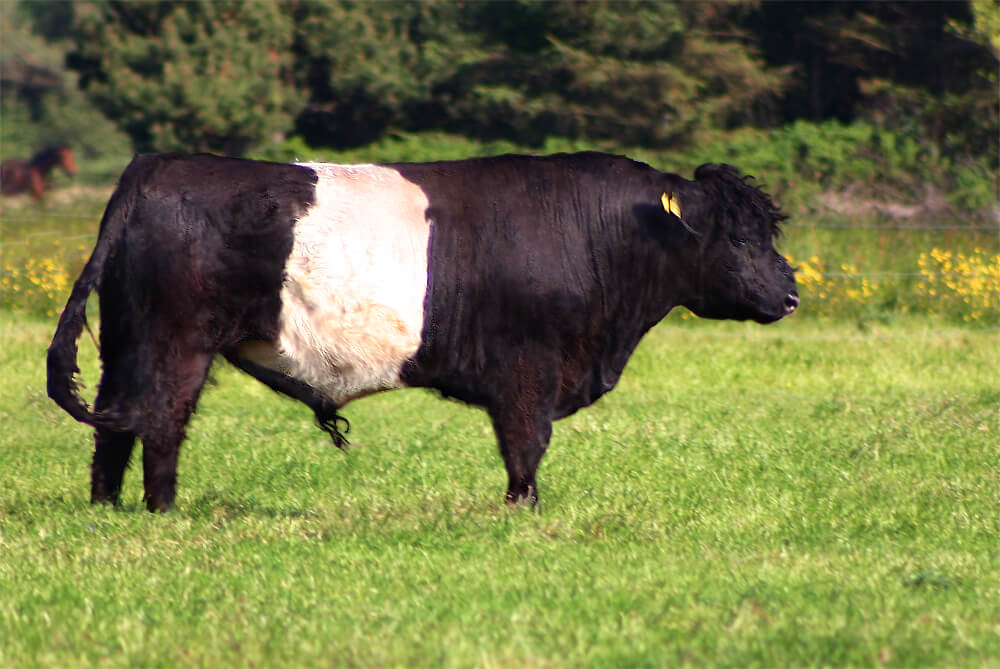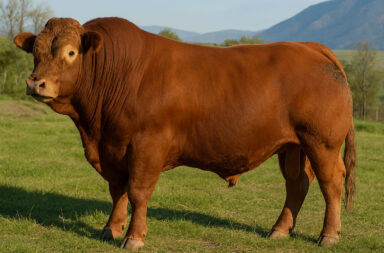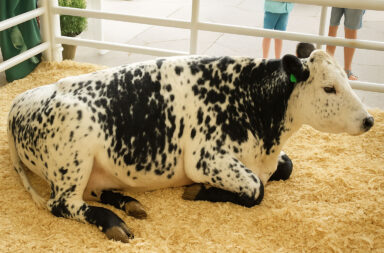
Image by Malene Thyssen from Wikimedia.
Belted Galloway Cattle: Ultimate survivor of Adverse climate.
History
The Belted Galloway cow thrives in challenging climates, catches the spotlight with its eye-catching white belt, is economical to raise, and originates from Scotland’s Galloway mountainous, harsh region.
The first Belted Galloway cow was brought to North America by the Graham brothers in 1853. And later in 1866 came to America. The breed’s official herd book was established in 1877.
Their name came from an Indigenous group of Scotland’s Galloway province named Gallovid (or Gaul). The Belted Galloway is also familiar as Oreo Cookie Cow and Belties.
One thing worth mentioning at the beginning is that don’t intertwine the Galloway and Belted Galloway as same breed. Although they share about 95% of their traits, they are officially recognized as separate breeds.
The key distinguishing feature of the Belted Galloway is the prominent white belt that wraps around the middle of its body.
It is unclear when and from where they got their white belt, but its white-colored belt closely resembles the Dutch Lakenvelder. Over time, in some lines, the white pattern disappeared, resulting in plain Galloway.
Belted Galloway at a glance

Designed by Freepik
- Belties can be black, red, or dun, and a white belt encircles their back stomach, giving them a distinctive appearanc
- Belted Galloway bull’s weight range is between 800-1,000 kilogram (1763-2204 lbs), and cow’s 450-680 kilogram (992-1499 lbs).
- Their demeanor is gentle.
- Belties have long lifespan (18-22 years)
- Belted Galloway calved once a year.
- Their body is covered with tow-layered hairy coat, which protects them from harsh adverse weather.
- Adaptable to both hot and cold weather.
- The Belted Galloway is polled.
- Their meat is delicious, lean, and healthy.
Characteristics
If you ask someone about the features of the Belted Galloway, they would most likely begin with its color. Because Belted Galloway’s most dominant characteristic is its white belt which encircles their back-stomach.
The rest of the body is typically black, red, or dun, creating a striking contrast with the white belt.
Their body is covered with dense, double-layered coat, formed by hair. The undercoat is short, soft, and thick. The outer coat is long, dense, and rough. This heavy, dense, tow-layered coat is their main weapon to fight bad weather.
In cold weather, their thick coat provides insulation against wind and low temperatures. Help them to hold their body temperature and reduce the cost of winter feeding.
On the other hand, in hot weather they lose far (shed), resulting in thinner coats, that work like shade in hot weather.
Thus, their double-layered coat helps them to regulate their body temperature both in hot and cold weather. Also excludes the cost of fancy/expensive housing. But we recommend giving them basic shelter.
Belted Galloway has a long lifespan, typically from 18 to 22 years, and is known for its gentle demeanor.
Bulls generally weigh between 800-1,000 kilograms (1763-2204 lbs), and cows weigh between 450-680 kilograms (992-1499 lbs)
In addition, they convert feed into weight very effectively, meaning they need less feed per kilogram of weight gain.
The Belted Galloway consumes wide variety of plants, which support them to survive in tough weather.
Besides, after butchering, over 60% of the cow’s live weight becomes usable meat. Which has made them an economical choice for farmers.
Normally, they give birth once a year. Also, they produce nutrient-rich milk. As a result, their calf becomes vigorous and grows fast. Calves are usually weaned around 205 days of age. This breed is also known for calving ease.
Cold hardiness/Adaptability
Due to their high adaptability, it is worth highlighting their resilient nature in a separate section. As we have said before, they have evolved in the harsh, tough, and rugged climate of Scotland’s Galloway mountainous region. So instinctively, they can adapt well to poor weather (both warm and cold). This hardiness also makes them significantly disease-resistant compared to other cow breeds.
Meet Quality and Market
The Belted Galloway meat is lean, flavorful, and healthy, containing only 2%-4% total fat and only 1% saturated fat. Thanks to their double-layered coat, these cattle don’t need to develop much subcutaneous fat to maintain body temperature. As a result, their meat stays naturally lean. There is demand for their meat in the organic and grass-fed market due to their quality and health benefits.
Belted Galloway Buying Guideline
If you are looking to buy the Belted Galloway Cattle, keep in mind below standard.
Desirable Female Traits
- Feminine appearance; avoid c
- Wide pelvis for easy calving (visible from rear).
- Udders: Four evenly sized and placed teats.
- Heifers: Teats are small and not fatty.
- Mature cows: Developed, non-pendulous udders.
Desirable Male Traits
- Masculine look, without excess neck/shoulder weight.
- The preputial sheath should be close-fitting, not pendulous.
- No signs of injury or swelling in the penis.
- Testicles: Large, symmetrical, c
- Bulls should have a strong libido and muscular build.
If you want to know more about their standard visit this guideline.
The belted Galloway is a tough, low-maintenance breed perfect for harsh climates. Its double coat, efficient feeding, and disease resistance have made it a practical and economical choice for farmers. The belted Galloway is a true survivor in every scenario.


